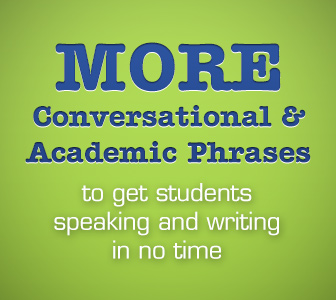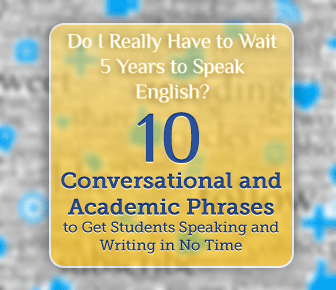More Conversational and Academic Phrases to Get Students Speaking & Writing in No Time


I didn’t want to tell them the cold facts: conventional wisdom, as well as research, suggests that it takes about 3 years for conversational proficiency and 5 years to learn a second language at a level to function in an academic setting. And while knowing these facts has kept me from investing in programs that claim a second language can be learned in two weeks, it has also somewhat discouraged me from pursuing further study in my own second languages, knowing the amount of time involved. And while I would certainly want to dissuade my students from investing in dubious language programs, I don’t want to discourage them from studying a second language altogether. Most of all, I want them to experience some immediate success with English. Small, immediate success helps students communicate in their second language and also motivates the learner to keep studying—necessary because language learning is a long, arduous task that requires persistence.
So instead of the first lessons in English being taken up with learning the verb “to be,” students should learn some language that is used a lot in speaking or writing, that students need to understand, and that they can take out that day and use and actually simulate some fluency in doing so. Prefabricated phrases, or ready-made phrases, like “How’s it going?” help toward these ends; in fact, research suggests language is actually learned and stored in memory in these phrases.

Signaling contrast, this phrase is often used in both writing and speaking. It has an intuitive appeal: most speakers can see the literal relationship of indicating a point (e.g., going out for Mexican food) “on one hand” and its contrast (e.g., going out for Chinese food) ”on the other hand”--sometimes even holding up their own hands when enumerating the points.
Strangely, however, although they understand the phrase, even native speakers sometimes mess up the form: “on the other hands,” “on a other hand,” etc. If students learn the form as a “frozen” one—e.g., it never changes—then this will clear up some errors.
This is a useful phrase for raising a point that the speaker has just been reminded of: e.g., “By the way (speaking of summer), have you had the air conditioner serviced?” Students often mishear this: I’ve seen it written “byderway,” which is what it sounds like, approximately. Therefore, teaching students the correct spelling and pronunciation gives them a useful tool in raising an important issue. It should however be noted that teaching students the literal meaning of phrases is often counterproductive: the literal meaning of “by the way” is only peripherally connected to its actual use.
This is another useful phrase for returning the conversation to an earlier point, often after having been interrupted: “As I was saying, it’s getting late, and we should go.” Since the phrase often serves as a gentle reminder that you were speaking and had made a point, it is especially helpful to ESL students, who might frequently be interrupted due to their uncertainty with the language.
This is a phrase often used to sum up a conversation and bring it to a close: “At any rate, I don’t know why the instructor is not here, but I need to go now.”
These are among the most common phrases in the English language and serve as sentence stems: they can be followed by almost any base verb: “I don’t want to go.” Learning how they are pronounced in rapid speech-- “I wannuh” and “I don’t wannuh”-- and how they are used will expand students productive language.
This is another phrase that if learned the way a native speaker says it in rapid speech (“Duh yuh know if--?”) can expand students’ fluency and productive speech because it can be followed with almost any short affirmative sentence: “Do you know if class meets at 8 am?”
This useful phrase signals a request in a very polite way and can be followed by almost any verb phrase: “Would you be willing to give me a ride home?”
This is especially as useful classroom language. Almost any word can stand in for “X,” and students can with this phrase expand their vocabulary.
Like item 8 above, this is also useful classroom language for expanding the speaker’s vocabulary. Again, if learned as a native speaker would say it (“Howd’yuh say—“), it can also simulate fluency.
This phrase is especially useful in writing and can be used to expand on a certain point: “San Francisco has many great tourist attractions. For example—”

There are numerous ways to teach the frequently used phrases of our language. One such method is simply to call attention to the phrases we use in speaking and writing: “Why did the actor in the TV show say ‘at any rate’? Why does the author use ‘on the other hand’ here?” Part of language learning is to understand speakers and writers actually do use the language learned in the classroom: it is not just an academic exercise.
Both of these exercises are great for learning form and meaning:
Fill in the blank: on__other hand
Match: on the other hand an opposite point
Hand out a list of phrases; give students a writing topic or speaking topic, and tell them to write or speak, working in three or five phrases from the list.
It is also probably stored in memory in phrases: when I think of my second languages, for example, what comes to mind are a few often-used phrases: “Ya ne znayu,” in Russian (“I don’t know”); “comment dit en francais—“ (“How do you say in French—“) and “Viyudaber Moishe” in biblical Hebrew (“And Moses said—“). Even today, if I throw out one of these phrases, I’ll get compliments from native speakers on my strong second language skills. I’ve actually plateaued at a low intermediate level in those languages, but I’ve learned a few phrases very well. And if I go to a Russian or French speaking country, I can get around and could advance further with study. Learning often-used phrases in your second language has strong practical, academic, cognitive, and motivational value.